As growers gear up for the 2020 season, many will be turning their attention towards their spring cropping plan. With a large increase in spring cropping area anticipated, growers will be aiming to secure seed supplies early this year.
The 2020 Department of Agriculture spring cereal recommended list has been published this week and provides an essential guide when planning this year’s spring cereal varieties.
The list sees a number of new varieties provisionally added, while a number of well-known varieties are now no longer in production.
Spring barley
Planet remains at the top of the table for yield. However, it ranks lowest for resistance to straw breakdown.
Gangway has slipped in terms of yield, but still has the highest KPH of 68.3.
SY Errigal is now fully recommended and has good disease resistance characteristics.
Spring oats
Barra remains on the list, while the two newer varieties, Delfin and Isabel, are also fully recommended.
Isabel tops the list in terms of straw strength and grain quality and has good disease resistance qualities. Delfin has the highest resistance to mildew.
Spring wheat
Well-known spring wheat varieties Doubleshot and Quintus have been removed, as they are no longer in production.
Newer varieties added to the recommended and provisionally recommended list such as Chilham, Starlight and Talisker are higher yielding and have good disease resistance characteristics.
With Corbel due to be lost, resistance to mildew becomes all the more important.
Variety ratings
Variety ratings are derived from the mean of data from the 2017-2019 trials, unless stated otherwise.
Assessment of key characteristics are based on a scale of one to nine. A high figure is desirable and indicates possession of the characteristic to a high degree.
For earliness of ripening, a difference of one point represents two days. Varieties with disease ratings of eight or over are very resistant. Seven indicates good resistance and six moderate resistance.
Five indicates moderate susceptibility, while four is rated susceptible. One to three are very susceptible. Figures are bracketed where information is limited.
Relative yield of each variety is calculated as a percentage of control varieties. The average yield of the control varieties equals 100.
Actual data is given for hagberg falling number, hectolitre weight, kernel content, protein content, screenings, straw height and thousand grain weight.
Read more
Key sector challenges up for discussion at the National Tillage Conference
Tillage – a year of many variables
As growers gear up for the 2020 season, many will be turning their attention towards their spring cropping plan. With a large increase in spring cropping area anticipated, growers will be aiming to secure seed supplies early this year.
The 2020 Department of Agriculture spring cereal recommended list has been published this week and provides an essential guide when planning this year’s spring cereal varieties.
The list sees a number of new varieties provisionally added, while a number of well-known varieties are now no longer in production.
Spring barley
Planet remains at the top of the table for yield. However, it ranks lowest for resistance to straw breakdown.
Gangway has slipped in terms of yield, but still has the highest KPH of 68.3.
SY Errigal is now fully recommended and has good disease resistance characteristics.
Spring oats
Barra remains on the list, while the two newer varieties, Delfin and Isabel, are also fully recommended.
Isabel tops the list in terms of straw strength and grain quality and has good disease resistance qualities. Delfin has the highest resistance to mildew.
Spring wheat
Well-known spring wheat varieties Doubleshot and Quintus have been removed, as they are no longer in production.
Newer varieties added to the recommended and provisionally recommended list such as Chilham, Starlight and Talisker are higher yielding and have good disease resistance characteristics.
With Corbel due to be lost, resistance to mildew becomes all the more important.
Variety ratings
Variety ratings are derived from the mean of data from the 2017-2019 trials, unless stated otherwise.
Assessment of key characteristics are based on a scale of one to nine. A high figure is desirable and indicates possession of the characteristic to a high degree.
For earliness of ripening, a difference of one point represents two days. Varieties with disease ratings of eight or over are very resistant. Seven indicates good resistance and six moderate resistance.
Five indicates moderate susceptibility, while four is rated susceptible. One to three are very susceptible. Figures are bracketed where information is limited.
Relative yield of each variety is calculated as a percentage of control varieties. The average yield of the control varieties equals 100.
Actual data is given for hagberg falling number, hectolitre weight, kernel content, protein content, screenings, straw height and thousand grain weight.
Read more
Key sector challenges up for discussion at the National Tillage Conference
Tillage – a year of many variables










SHARING OPTIONS